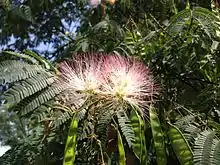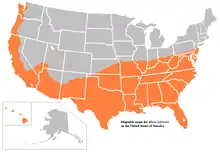Albizia julibrissin
Albizia julibrissin, the Persian silk tree or pink silk tree, is a species of tree in the family Fabaceae, native to southwestern and eastern Asia.[1]
| Albizia julibrissin | |
|---|---|
 | |
| Habitus | |
| Scientific classification | |
| Kingdom: | Plantae |
| Clade: | Tracheophytes |
| Clade: | Angiosperms |
| Clade: | Eudicots |
| Clade: | Rosids |
| Order: | Fabales |
| Family: | Fabaceae |
| Clade: | Mimosoideae |
| Genus: | Albizia |
| Species: | A. julibrissin |
| Binomial name | |
| Albizia julibrissin Durazz., 1772 non sensu Baker, 1876 | |
| Synonyms | |
|
Many, see text | |



The genus is named after the Italian nobleman Filippo degli Albizzi, who introduced it to Europe in the mid-18th century, and it is sometimes incorrectly spelled Albizzia. The specific epithet julibrissin is a corruption of the Persian word gul-i abrisham (گل ابریشم) which means "silk flower" (from gul گل "flower" + abrisham ابریشم "silk").
Albizia julibrissin was described by Antonio Durazzini. John Gilbert Baker used the same scientific name to refer to Prain's Albizia kalkora, the Mimosa kalkora of William Roxburgh.
Names
Albizia julibrissin is known by a wide variety of common names, such as Persian silk tree and pink siris. It is also called Lenkoran acacia or bastard tamarind, though it is not too closely related to either genus. The species is called Chinese silk tree, silk tree or mimosa in the United States, which is misleading – The former can refer to any species of Albizia which is most common in any one locale; and, although once included in Mimosa, neither is it very close to the Mimoseae. To add to the confusion, several species of Acacia, notably Acacia baileyana and Acacia dealbata, are also known as "mimosa" (especially in floristry), and many Fabaceae trees with highly divided leaves are called thus in horticulture.
Its leaves slowly close during the night and during periods of rain, the leaflets bowing downward; thus its modern Persian name shabkhosb (شبخسب) means "night sleeper". In Japan its common names are nemunoki, nemurinoki and nenenoki which all mean "sleeping tree". Nemu tree is a partial translation of nemunoki.
.png.webp)
Description
Albizia julibrissin is a small deciduous tree growing to 5–16 m (16–52 ft) tall, with a broad crown of level or arching branches. The bark is dark greenish grey in colour and striped vertically as it gets older. The leaves are bipinnate, 20–45 cm (8–18 in) long and 12–25 cm (5–10 in) broad, divided into 6–12 pairs of pinnae, each with 20–30 pairs of leaflets; the leaflets are oblong, 1–1.5 cm (0.4–0.6 in) long and 2–4 cm (0.8–1.6 in) broad. The flowers are produced throughout the summer in dense inflorescences, the individual flowers with small calyx and corolla (except the central ones), and a tight cluster of stamens 2–3 cm long, white or pink with a white base, looking like silky threads. They have been observed to be attractive to bees, butterflies and hummingbirds. The fruit is a flat brown pod 10–20 cm (4–8 in) long and 2–2.5 cm (0.8–1.0 in) broad, containing several seeds inside.
There are two varieties:
- Albizia julibrissin var. julibrissin – the typical variety, described above
- Albizia julibrissin var. mollis – differs in the shoots being densely hairy
Habitat, cultivation and uses
Original habitats of the tree include regions from Iran (Persia) and the Republic of Azerbaijan to China and Korea.[2]
A. julibrissin is widely planted as an ornamental plant in parks and gardens, grown for its fine leaf texture, flowers and attractive horizontal canopy. Other positive attributes are a fast growth rate, low water requirements and the ability to thrive planted in full sun in hot summer climates.[3] It is very frequently planted in semi-arid areas like California's Central Valley, central Texas and Oklahoma. Although capable of surviving drought, growth will be stunted and the tree tends to look sickly. As such it should be given infrequent, deep waterings during the summer, which will benefit growth and flowering.[4]
The broad crown of a mature tree makes it useful for providing dappled shade. The flower colour varies from white in A. julibrissin f. alba, to rich red-tipped flowers. Variants with cream or pale yellow flowers are also reported. Other cultivars are becoming available: 'Summer Chocolate' has red foliage ageing to dark bronze, with pale pink flowers; 'Ishii Weeping' (or 'Pendula') has a drooping growth habit.
A. julibrissin f. rosea
There is also a form, A. julibrissin f. rosea (pink silk tree) which has, in the past, been classed either as a variety or as a cultivar. This is a smaller tree, only growing to 5–7 metres (16–23 ft) tall, with the flowers always pink. Native to the northeast of the species' range in Korea and Northern China, it is more cold-tolerant than the typical form, surviving temperatures down to at least −25 °C (−13 °F). The selected cultivar A. julibrissin 'Ernest Wilson' (also known as 'E.H.Wilson' or 'Rosea') is a cold-tolerant tree with deep pink flower colour. In Japan, A. julibrissin f. rosea is often used for non-traditional bonsai. The name nemunoki* (ねむの木, Kanji: 合歓木) and its variants is a kigo representing the summer in haiku, especially a sleepy summer evening.[5]
A. julibrissin f. rosea has gained the Royal Horticultural Society's Award of Garden Merit;[6] likewise the cultivar 'Summer Chocolate'.[7]
Other uses
The sweet-scented flowers are a good nectar source for honeybees and butterflies.
There is conflicting information on the toxicity of pods and seeds to humans and animals; some parts of the plant may contain neurotoxin. Consult with a medical professional expert before eating or feeding.
Invasive species
In the wild, the tree tends to grow in dry plains, sandy valleys, and uplands. It has become an invasive species in the United States, where it has spread from southern New York, New Jersey and Connecticut, west to Missouri and Illinois, and south to Florida and Texas. It is cultivated in California and Oregon. Its seeds are numerous and they are fertile even over long periods of drought. Each pod, which resembles a flattened bean pod made of paper, contains an average of 8 seeds. The pods burst in strong winds, and the seeds carry over surprisingly long distances.

Breeding work is currently under way in the United States to produce ornamental plants which will not set seed and can therefore be planted without risk. However, in the eastern United States it is generally a short-lived tree, being highly susceptible to mimosa vascular wilt,[8] a fungal disease caused by a species of Fusarium, though the disease does not seem to have seriously impacted its populations. Because of its invasive tendencies and disease susceptibility, it is rarely recommended as an ornamental plant in the US, though it is still widely planted in parts of Europe.
References
- "Plant of the Week". Gardens.co.nz. Archived from the original on 2013-02-08. Retrieved 2014-04-18.
- Juan-Alberto Rodriguez Pérez, Flore exotique dans les îles Canaries, Leon, Espagne, Editorial Everest, 1990. ISBN 84-241-4668-9). Page 11
- Kathleen Norris Brenzel (ed.) (2007). Sunset Western Garden Book. p. 178.CS1 maint: extra text: authors list (link)
- Kathleen Norris Brenzel (ed.) (2007). Sunset Western Garden Book. p. 178.CS1 maint: extra text: authors list (link)
- 合歓の花(ねむのはな) 晩夏 (in Japanese). kigosai.sub.jp. Retrieved 2011-06-27.
- "RHS Plant Selector Albizia julibrissin f. rosea AGM / RHS Gardening". Apps.rhs.org.uk. Retrieved 2020-03-12.
- "Albizia julibrissin 'Summer Chocolate'". RHS. Retrieved 27 February 2020.
- Fusarium Wilt of Mimosa (Albizia julibrissin), Virginia Cooperative Extension
External links
| Wikimedia Commons has media related to Albizia julibrissin. |